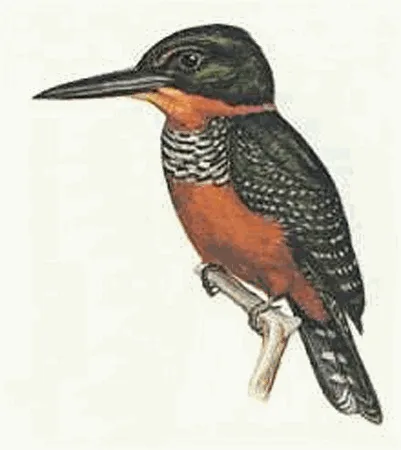
Green-and-rufous Kingfisher
[order] CORACIIFORMES | [family] Alcedinidae | [latin] Chloroceryle inda | [UK] Green-and-rufous Kingfisher | [FR] Alcyon bicolore | [DE] Zweifarben-Fischer | [ES] Martin Pescador Verdirrufo | [NL] Groenbruine IJsvogel
Subspecies
Monotypic species
Physical charateristics
The adult male has glossy green upperparts, with white spotting on the wings, and a rufous nape and underparts. The female has a narrow green breast band. Young birds resemble the adult female, but have more spotting on the wings and back. There are no recognised subspecies of Green-and-rufous Kingfisher. The Green-and-rufous Kingfisher resembles the American Pygmy Kingfisher which shares its range, but it is much larger than its relative, and four times as heavy. It lacks the white lower belly shown by the smaller species, and has more white spots on the wings.
Listen to the sound of Green-and-rufous Kingfisher
[audio:http://www.aviflevoland.nl/sounddb/G/Green-and-rufous Kingfisher.mp3]
Copyright remark: Most sounds derived from xeno-canto
| wingspan min.: | 0 | cm | wingspan max.: | 0 | cm |
| size min.: | 23 | cm | size max.: | 24 | cm |
| incubation min.: | 0 | days | incubation max.: | 0 | days |
| fledging min.: | 0 | days | fledging max.: | 0 | days |
| broods: | 1 | eggs min.: | 3 | ||
| eggs max.: | 5 |
Range
Latin America : Nicaragua to North Bolivia, Southeast Brazil
Habitat
Not uncommon along rivers, streams and creeks with dense vegetation. In Suriname found in overgrown plantation creeks and mangroves.
Reproduction
Nest tunnel exavated in a riverbank. Clutch size is 3-5 eggs. No further data.
Feeding habits
Hunts for fish and crab mostly at dusk and dawn. Perches low above water and dives head first. Feeds also on water insects.
Conservation
This species has an extremely large range, and hence does not approach the thresholds for Vulnerable under the range size criterion (Extent of Occurrence <20,000 km2 combined with a declining or fluctuating range size, habitat extent/quality, or population size and a small number of locations or severe fragmentation). The population trend appears to be stable, and hence the species does not approach the thresholds for Vulnerable under the population trend criterion (>30% decline over ten years or three generations). The population size has not been quantified, but it is not believed to approach the thresholds for Vulnerable under the population size criterion (<10,000 mature individuals with a continuing decline estimated to be >10% in ten years or three generations, or with a specified population structure). For these reasons the species is evaluated as Least Concern.

Migration
Sedentary throughout range, but may disperse to flooded areas
Distribution map

